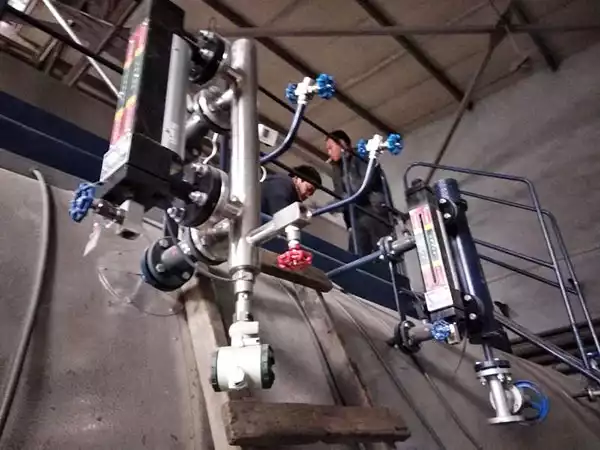Introduction
Steam boilers are a common way to heat your home or business. They’re also used in industrial settings and as part of power plants. Steam boilers come in many shapes and sizes, but they all operate on the same principle: water is heated until it boils into steam and then this steam is used to heat the spaces you want heated. The most common type of boiler is an oil-fired boiler, which uses oil as its fuel source. A hot water boiler is another option that works similarly to an oil-fired model with some key differences; instead of using an open flame to burn the fuel, hot water boilers use electric coils under pressure or natural gas burners in order to create enough heat for boiling water within them.
Need a new boiler?
What is a Steam Boiler?
A steam boiler is a device that uses water as its heating medium. Water is heated in the boiler, causing it to boil and turn into steam. The resulting high-pressure, high-temperature steam then drives a turbine which creates electricity or mechanical power. After use, the condensed liquid returns to be reheated in another cycle; this process is known as “recirculating”.
Steam boilers are used for:
The industrial production of steam, which is used in many industries including power generation. The heating of buildings and other structures through the use of steam radiators.
![How Much Does a Steam Boiler Cost to Install? 2 Best Steam boiler replacement cost in [2023]](https://www.saleboilers.com/wp-content/uploads/2023/01/19.webp)
Best Steam boiler replacement cost in [2023]
How do you set up a steam boiler?
Setting up a steam boiler involves several steps, including site preparation, selecting the right unit, installing the unit, and commissioning the unit. Here’s a general outline of the process:
Site Preparation: Determine the location of the unit and evaluate the structure and flooring to ensure they can support the weight. Make sure the location complies with local building codes and regulations.
Select the Right Unit: Consider the size of your facility, your energy needs, and your budget to determine the right unit for your needs. Consult with a professional to ensure you choose the right steam boiler.
Installing the Steam Boiler: Connect the unit to a fuel source and install the necessary pipes and valves. Connect the unit to the heating elements, such as radiators or baseboards, following the manufacturer’s instructions and local building codes. Hire a qualified professional to perform the installation.
Commissioning the Steam Boiler: After the installation is complete, test the unit’s safety systems, verify that the fuel supply and ignition systems are working correctly, and check for proper ventilation.
It’s essential to follow the manufacturer’s instructions and local building codes during installation to ensure the unit operates safely and efficiently. Additionally, it’s crucial to hire a qualified professional to perform the installation to avoid any potential risks or hazards.

Coal fired hot water boiler system
How much does it cost to install a steam boiler?
The cost to install a steam boiler depends on the size of your home and what type of system you want to install. For example, if you live in an older house with little insulation and no central air conditioning, then it’s likely that installing a high-efficiency central heating system will be more expensive than if you live in an energy-efficient new home with plenty of insulation and other features like double-pane windows.
The cost of installing a steam boiler can vary widely depending on several factors such as the type of boiler, the size of your home, the complexity of the installation, and the geographical location. On average, a steam boiler installation can cost anywhere from $3,000 to $10,000 or more. It is best to get a detailed quote from a licensed HVAC contractor to get an accurate estimate for your specific needs.
Get FREE Boiler Quotes
- ✔Get FREE Local Boiler Quotes today
- ✔Compare The Best Prices
- ✔Save Money On Your New Boiler Today!
What is the most important part of installing a steam boiler?
When installing a steam boiler, it’s important to consider the location of your new boiler. The ideal spot for a steam boiler is in a basement or garage, but this may not be possible for everyone. If you live in an apartment building or condo complex with shared walls between units, then you’ll need to check with your landlord before installing anything that could potentially cause damage to other units’ walls or ceilings.
If you do have access to an indoor space where you can install your own plumbing system without causing any problems with neighbors or building management staff members (and if there are no fire codes prohibiting such activities), then by all means go ahead!
How long does it take to install a steam boiler?
The time it takes to install a steam boiler depends on several factors such as the size of the boiler, the location of the installation, the complexity of the piping and electrical connections, and the number of technicians involved in the installation. Typically, the installation of a steam boiler can take anywhere from a few days to several weeks. It’s important to note that the exact time it takes may vary based on the specific circumstances of each individual installation.

industrial hot water boiler price
How much does an industrial steam boiler cost?
industrial steam boiler cost
The cost of a new steam boiler installation can be anywhere from $5,000 to $20,000. The size and type of your particular boiler will determine its price range, but there are some general guidelines that you can follow when deciding whether or not it’s worth investing in an industrial-sized model.
If you’re looking for a more affordable option, consider purchasing an older model instead of having a new one installed. If your business doesn’t require high-powered steam heat–such as if it operates year-round and is located in a temperate climate–then replacing an existing unit may not be necessary. However, if this isn’t the case (for example: if your company operates around the clock; has fluctuating demand for heat throughout each day; or operates in an area where temperatures drop below freezing), then upgrading might be worth exploring further before making any decisions about what kind of boiler would work best for your needs.
Which type of boiler is most efficient?
The most efficient type of boiler is an oil-fired boiler. They are more efficient than gas-fired boilers and they also burn cleaner, which means they produce less carbon dioxide emissions.
However, these types of boilers are more expensive to install than their counterparts; so if you want to save money on your energy bills then a gas-fired boiler would be a better option for you.
What does a new boiler installation include?
A boiler installation includes:
- The boiler itself, which is the heating system’s heart. It produces hot water that flows through pipes to heat radiators or baseboards. Boilers are made from stainless steel, cast iron or aluminum alloy.
- The water feed line(s), which bring in cold water from your home’s plumbing system and carry it to the boiler where it’s heated up before being sent back out into your home via a return pipe (or more than one).
- Controls that regulate how much heat gets produced by your heating system so you can set it at different temperatures depending on what time of year it is and how cold/warm outside temperatures are at any given moment in time!
Need a new boiler?
What do I need to know when buying a boiler?
Before you make any decisions, there are a few things to consider. First and foremost, what is the power capacity of your current boiler? This is important because it will dictate how much water can be heated at once. If you have an older model that only heats a couple gallons per minute (gpm), then upgrading to something with more horsepower may not be necessary if all you need is hot water for washing dishes or taking baths.
Next consider what type of boiler would work best for your needs: gas or electric? Gas has been around longer than electricity so they tend to be more reliable but require more maintenance than electric ones do–especially if they’re propane powered rather than natural gas powered because then there’s no worry about having access to an outlet nearby! On top of those factors though comes price point; while both options are relatively inexpensive compared with some other types like solar panels or wind turbines which can cost thousands upon thousands depending on their size/output capabilities…
Conclusion
We hope that this article has given you a better understanding of what goes into installing a steam boiler. As we have seen, there are many factors that influence the cost of installation and the time it takes to complete this process. In addition, there are also many different types of boilers available on the market today which means there are many different options when deciding what type is right for your home or business! If you want more information about getting started with your own project please contact us today!

Looking for boilers with sophisticated manufacturing, great quality?
Fangkuai boiler can always provide what you want.


